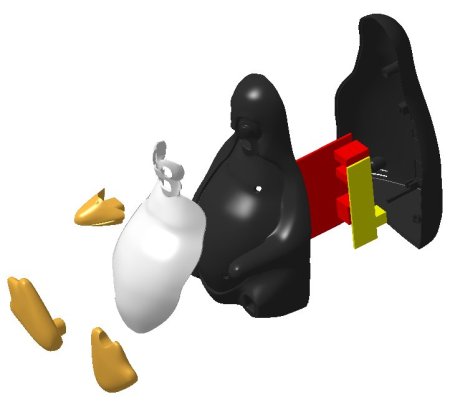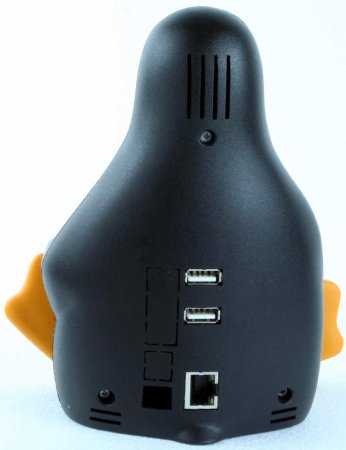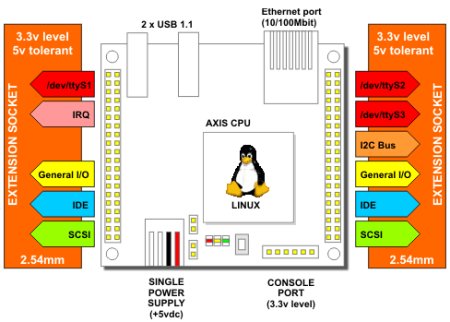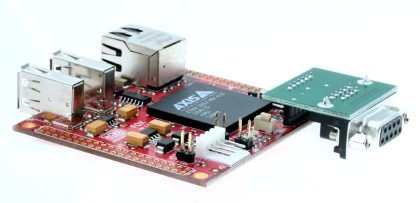Tux-shaped computer runs Linux
Feb 28, 2006 — by LinuxDevices Staff — from the LinuxDevices Archive — 58 views Acme Systems is shipping a Penguin-shaped case for a tiny SBC (single-board computer) powered by an innovative MCM (multi-chip module) that runs Linux. The 6.7-inch tall, 30-Euro “Tux Case” houses the company's “Acme Fox,” a 2.6 x 2.8-inch, 100-Euro, RISC-based board with Ethernet and dual-USB interfaces, and surface-mount… connectors for other I/O.
Acme Systems is shipping a Penguin-shaped case for a tiny SBC (single-board computer) powered by an innovative MCM (multi-chip module) that runs Linux. The 6.7-inch tall, 30-Euro “Tux Case” houses the company's “Acme Fox,” a 2.6 x 2.8-inch, 100-Euro, RISC-based board with Ethernet and dual-USB interfaces, and surface-mount… connectors for other I/O.
(Click for larger view of Tux Case)
Acme is based in Italy, but offers an English translation of its website that explains, “TUX Case is made up of six coloured parts in PVC: pecker, right and left legs are yellow, tummy, face and eyes sockets are made with one white part, front and back half are black.”

The Tux Case comprises six pieces of colored plastic
(the red piece represents the SBC — click to enlarge)
The case offers rear-mounted I/O ports for standard I/O, along with break-out ports for an available optional serial port, and possibly a planned RJ-11 modem connector.

Back panel I/O
(Click to enlarge)
What's inside Tux?
The Tux Case is designed to house Acme's tiny, RISC processor-based Acme Fox SBC, which was released in late March of last year, along with a Linux software cross-development kit.

The “Acme Fox” board inside Tux
(Click to enlarge)
The Acme Fox was among the first SBCs based on Axis Communications's Etrax 100LX MCM. The Axis MCM uses “high-density packaging” (HDP) technology that allows “naked dies” — an SoC, RAM, Flash, and I/O components, for example — to be combined into a single chip, for reduced footprint and BOM (bill-of-materials). The Etrax 100LX weds a RISC-based SoC (system-on-chip) with 4MB of Flash, 16MB RAM, an Ethernet transceiver, and “various interface components,” and requires only 3.3V power and a 20MHz crystal in order to run Linux, Acme says.
The SoC used in the MCM is Axis's Etrax 100LX, based on a 32-bit RISC instruction, and said to deliver 100 MIPS (millions of instructions per second). The SoC integrates on-chip controllers for 10/100 Mbit Ethernet, four high speed serial ports, two USB ports for both host and device, IDE, SCSI, and two IEEE-1284 “fast” parallel ports.
The Acme Fox's I/O connectors include 10/100 Ethernet and two USB ports. Twin surface-mount connectors expose other available I/O, as shown below.

Surface-mount connectors offer additional I/O
The board also has a serial port pin header that uses the board's 3.3V signal, but can be turned into a normal serial port with an available “Fox Console” board.

The optional Fox Console board can be wired or direct-plugged
On the software side, the Acme Fox comes with a 2.4.31 Linux kernel, but can easily be upgraded to 2.6.12, the company says. Also included is glibc; Linux drivers for USB flash, hard drives, and USB-to-serial converters; servers for http, ftp, telnet, ssh, ppp; and applications that include wget, vi, easyedit, and busybox shell commands and utilities.
An included Linux software cross-development kit supports C language development on Debian or Red Hat Linux hosts. A free C compiling service is also available on the Web. The Acme Fox also supports PHP development, optionally with the open source SQLite database.
Availability
The Acme Fox, Fox Console, and Tux Case are all available now. Acme says it produced 1,000 Tux cases initially, and the company's direct sales page includes a decrementing counter.
This article was originally published on LinuxDevices.com and has been donated to the open source community by QuinStreet Inc. Please visit LinuxToday.com for up-to-date news and articles about Linux and open source.